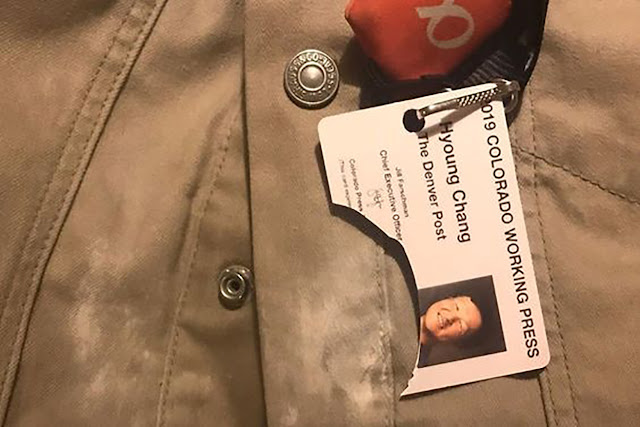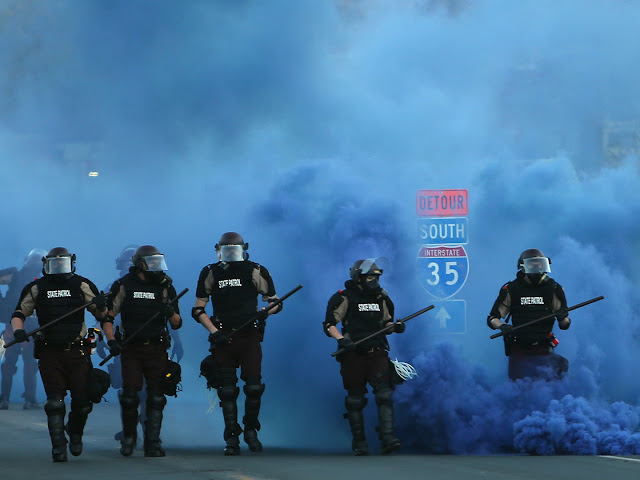 |
| Hyoung Chang, a Denver Post photographer, took this photo of his broken press pass after police fired “a projectile” at him. USA Today later reported the “projectile” actually was “two pepper balls [fired] directly at him.” (Hyoung Chang, via the New York Times) |
Freedom of the Press has met The Right to Peaceably Assemble in the streets of many cities all over the USA, this summer. And both provisions of the First Amendment have too often been trampled by authorities who should know better.
When police themselves break the law
Don’t believe it? Watch this short video from VICE News.
No, these were clearly members of the press. Licensed and trained sworn officers should have known they had a right to be there. Law enforcement agents who knowingly break the law vividly illustrate why so many people have begun to protest that they need to be defunded, abolished, or at least redefined. If they themselves can’t be trusted to follow the law, why are we paying them and maintaining a police force at all?
Unfortunately, these aren’t the only documented cases. Journalists from two different agencies, The US Press Freedom Tracker and Nick Waters of Bellingcat, who created a Twitter thread to count incidents, each independently identified about 100 instances, just in the first weeks of protests. By June 6, Forbes reported “328 . . . and counting.”
As I write this, The US Press Freedom Tracker’s count is considerably higher: “600+ aggressions against the press during national Black Lives Matter protests,” 157 journalists attacked, and 51 journalists arrested. Their equipment hasn’t been spared, either. The US Press Freedom Tracker says police damaged equipment 43 times, and have searched or seized it 10 times.
The next video, from The Washington Post, shows new examples, in addition to some shown in the previous video.
I’ll share a link to one more video, to offer an even more comprehensive overview, and an international perspective. Although the video is in English, DW is a German news agency (hint: the part about attacks on the press ends 2 minutes before the video does).
How much harm are they doing?
When authorities attack journalists and protesters, it does a lot of harm. Trampled Constitutional rights are serious breaches of the law and deeply un-American. But these attacks also can do serious physical and psychological harm.
Most of the protests have been peaceful. And journalists should be completely off-limits. But this summer police have freely used a variety of so-called “less-lethal” weapons on both groups.
What is a “less-lethal” weapon? Police have a variety at their disposal. They used to be called “nonlethal,” but that turns out to be wrong. They can and have caused death.
 |
Projectile weapons can leave bruises, lacerations, broken bones. If you’re hit in the eye like photographer Linda Tirado, you can be blinded. That’s why the American Academy of Ophthalmology called for a nationwide ban on the use of rubber bullets against protesters.
In a recent article USA Today quoted Charlie Mesloh, a certified instructor on the use of police projectiles and a professor at Northern Michigan University, who said, “On day one of training, they tell you, ‘Don’t shoot anywhere near the head or neck.’ That’s considered deadly force.”
Eye doctors are no fans of tear gas or other chemical irritants, either. Neither are experts on respiratory diseases—especially in a time of COVID-19 pandemic. Tear gas causes a variety of effects. Most go away after a while. But people with respiratory problems can struggle with the effects for a long time.
 |
Minneapolis police advance through tear gas toward a group of protesters. (Scott Olson/Getty Images, via NPR). |
Why are the police acting this way?
This kind of police aggression toward journalists is not only unconstitutional. It’s also not normal. Why act this way? Why now?
As I discussed in previous post, it’s very difficult to hold police accountable in the current legal climate. But perhaps they feel more empowered than usual. Many commentators point to the president as part of the reason why that might be.
He’s been an outspoken critic—to the point where he’s used inflammatory, authoritarian phrases such as “enemy of the people” when speaking of the press. Various groups have protested this treatment, to no avail.
I don't mean to say the president is the only reason for this change. Am I his fan? No. Is he the first president to have issues with the press? Hardly! Speaking truth to power is dangerous. But there’s something at work here that goes beyond Mr. Trump.
Police officers and police departments feel empowered to lash out against journalists as they never have before this summer. All too predictably, many of the journalists targeted also appear to be BIPOC and/or women.
When American authorities attack journalists and protesters, this is new in the Twenty-First Century. This is disturbing.
This is dangerous.
IMAGE CREDITS
I really want to thank Hyoung Chang, via the New York Times, for the photo of his broken press badge. I appreciate YouTube and VICE News for the first video, YouTube and The Washington Post for the second video, and YouTube and DW for the third. Many thanks also to the Washington Post for the excellent illustration and article on “Less-Lethal” police weapons and their dangers. And to NPR and photographer Scott Olson for the image of Minneapolis police in riot gear, striding through billows of tear gas smoke.
No comments:
Post a Comment